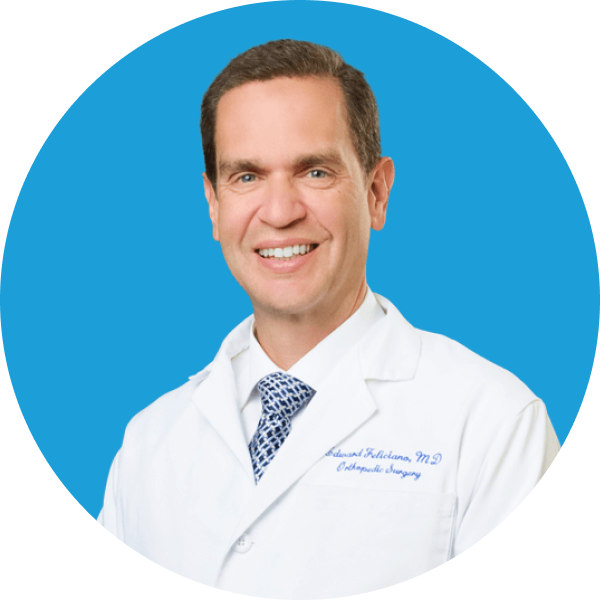Back, Neck, and Spinal Conditions
The spine, also known as the backbone, vertebral column, or spinal column, is a complex structure that runs from your neck to the tailbone in your lower back. It is one of the most important anatomic structures in the human body, as it provides structural support for the weight of your head and body. It also forms the spinal canal, which encloses and protects the spinal cord. The spinal cord’s primary function is to gather sensory information from the nerves throughout the body and act as a messenger between the brain and the body. Together, the spinal cord and brain form the central nervous system, which controls our functions and movements. Everything the human body does is made possible by the spinal system.
Back, neck, and spine pain are common, and one of the top reasons people see an orthopedic specialist. The pain can be anything from a minor annoyance to being so severe that it hinders your ability to perform normal everyday activities.
We Specialize in Treating
Back Pain/Injury
Herniated Disc
Neck Pain/Injury
Piriformis Syndrome
Radiculopathy
Sciatica (Sciatic Nerve Pain)
Scoliosis
Spinal Stenosis
Spondylosis
Whiplash
All Back & Neck Conditions
- Back Pain/Injury
- Back Spasm
- Bulging Disc
- Car Accident Injuries
- Cervical Pain
- Cervical Radiculopathy
- Cervical Sprain
- Complex Regional Pain Syndrome
- Degenerative Disc Disease
- Diabetic Neuropathy
- Disc Extrusion
- Drop Foot
- Facet Joint Syndrome
- Failed Back Surgery Syndrome
- Fibromyalgia
- Headache
- Herniated Disc
- Kyphosis
- Lower Back Pain/Injury
- Lumbar Pain
- Lumbar Radiculopathy
- Mid Back Pain/Injury
- Muscle Spasm
- Muscle Trigger Points
- Myofascial Pain Syndrome
- Neck Pain/Injury
- Neck Spasm
- Neck Stiffness
- Nerve Impingement (Radiculopathy)
- Nerve Pain
- Numbness and Tingling
- Pinched Nerve
- Piriformis Syndrome
- Post Laminectomy Syndrome
- Prolapsed disc
- Radiculopathy
- Sacroiliac Joint Dysfunction
- Sciatica (Sciatic Nerve Pain)
- Scoliosis
- Slipped Disc
- Spinal Arthritis
- Spinal Bone Spurs
- Spinal Fracture
- Spinal Infection
- Spinal Stenosis
- Spondylolisthesis
- Spondylosis
- Sports Injuries
- Thoracic or Lumbar Sprain/Strain
- Vertebral Compression Fracture
- Whiplash
Get Advanced Back, Neck, and Spine Care Right In Your Neighborhood
Finding the treatment that’s right for your back, neck, or spine problem is our focus at The Orthopedic Health Center. We use non-surgical treatments whenever possible. When you do need surgery, our expert surgeons help you heal faster and with less pain. All right in your neighborhood: Hoboken, Jersey City, or Bayonne
Anatomy of the Spine
Running from the bottom of the skull to the pelvis, the spine consists of 33 interlocking vertebrae, which are small irregular bones stacked on top of each other to support the body’s skeletomuscular form. The spine is split into five segments:
- The cervical spine: located in the neck and consisting of seven vertebrae, the cervical spine is responsible for our ability to move and turn our heads.
- The thoracic spine: located in the middle back and consisting of 12 vertebrae, the thoracic spine is a sturdy structure that provides a great deal of support to the body. It’s also the part of the spine that holds the rib cage.
- The lumbar spine: located in the lower back and consisting of five vertebrae, the lumbar spine plays an important role in our ability to bend at the waist.
- The sacral spine: a large triangular bone that is actually five smaller bones that have fused into one structure. It connects the upper portions of the spine with the hips and stabilizes the pelvis.
- The coccyx: an arrangement of small fused bones that is commonly referred to as the tailbone. It provides weight-bearing support to your body and serves as a connecting point for various muscles and soft tissues.
The bones of the spine are held together and supported by a complex network of joints, muscles, tendons, ligaments, cartilage, and discs.
Muscles of the Spine, Back, and Neck
Muscles are tissue that provides you with the power and control to move your body. For the neck and back to function properly, the spine is supported primarily by two types of muscles: intrinsic muscles (also known as deep muscles) and superficial muscles. Intrinsic muscles are attached to the spine, while superficial muscles are closer to the surface of the body. These muscles stabilize the spine and make it possible for you to move your neck from side to side, nod your head, look around, lift your shoulder blades, bend, stand up, sit down, lift objects, and more.
Tendons and Ligaments of the Spine
Tendons and ligaments are both tough bands of fibrous cords of connective tissue that provide stability and support to anatomical structures. In the spine, these two types of tissue work together to hold the spine together, facilitate movement, and strengthen joints. Tendons connect muscle to bones, while ligaments connect bones or cartilage to each other.
Cartilage and Discs of the Spine
Cartilage is a type of smooth and slippery tissue that cushions and protects joints, preventing them from rubbing against each other. In the spine, cartilage covers the ends of the facet joints, which is the point of connection between the bones of the spine. The smooth and slippery texture of cartilage allows the vertebrae to slide against each other without breaking, providing the body with flexibility and stability.
The spine is also supported by spinal discs, which are rubbery pads located between the vertebrae. Spinal discs have a hard exterior of fibrous cartilage that surrounds a soft, jelly-like core. These discs act as shock-absorbing cushions between the vertebrae.
Back, Neck, and Spine Pain FAQ
A: Orthopedic doctors and orthopedic surgeons specialize in the treatment of musculoskeletal pain, including bones, joints, muscles, ligaments, and tendons. If you’re experiencing pain in your neck, back, or anywhere else along your spine, you should consider scheduling an appointment with an orthopedic specialist.
A: There are many daily activities that can cause or exacerbate back, neck, and spinal pain, including:
- Lifting heavy objects
- Frequent bending
- Slouching
- Sitting for prolonged periods
- Holding your head in an odd position
- Sleeping on a pillow that doesn’t provide proper support
- Sleeping in a way that twists or bends your neck
- Exercising with improper technique
Spinal pain and injuries can occur in the home, at work, or while playing sports. The bottom line is that any activity that puts extensive strain on your back, neck, and spine can cause pain.
A: In some cases, you may be able to alleviate back and neck pain with at-home self-care. One of the main recommendations for improving back and neck pain is to actively work on improving your posture. This includes making sure your spine is straight while standing or sitting, sleeping on your side or back, using a supportive pillow, and adjusting your computer monitor so that the top of your screen is at eye level. Other at-home methods include ice and heat application and over-the-counter pain relievers. However, if your back and neck pain is significant or interferes with your daily life, consider scheduling an appointment with an orthopedic back and neck specialist.
A: Orthopedic specialists typically only recommend spinal surgery as a last resort after all other treatments have failed. In the vast majority of cases, back and neck pain can be treated with non- or minimally-invasive care.
The Most Advanced Surgical Techniques
Take a closer look at the level of care to expect at The Orthopedic Health Center.
Back, Neck, and Spinal Pain
Because the spine is so complex and large, there are a wide variety of anatomical reasons why you might be experiencing pain anywhere along the back and neck. Some of the most common causes of back and neck pain involve the spinal facet joints, muscles, nerves, and discs. However, many causes of back and neck pain often feel similar to one another, making it difficult to identify the exact source.
If you’ve been experiencing back or neck pain that doesn’t go away, is accompanied by numbness or tingling, extends into other parts of your body, or worsens at night, it’s recommended that you schedule an appointment with an orthopedist who specializes in back, neck, and spinal pain for a proper diagnosis
Comprehensive Orthopedic Care for Back, Neck, and Spinal Pain
From injuries to chronic conditions, the back, neck, and spine specialists of The Orthopedic Health Center can help you find the pain relief you’re looking for. We focus on providing non-surgical options whenever possible. Our treatment options for back, neck, and spinal pain include:
- Complete Spine Care
- Sports Medicine
- Pediatric Orthopedics
If necessary, our expert orthopedic doctors and surgeons will perform minimally-invasive procedures so that you can heal faster with less pain. Contact us today for advanced orthopedic care for back, neck, and spinal pain.
Edward Feliciano, MD
Director of Orthopedic Surgery
Edward Feliciano, MD is a board-certified orthopedic surgeon and the Director of Orthopedic Surgery with training from Yale, Cornell and Georgetown University.
Appointments available now.















